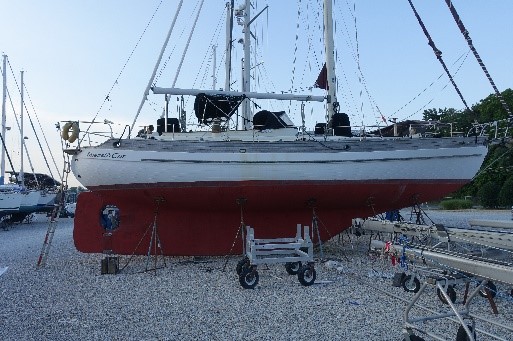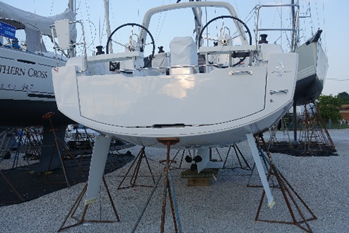Stability
Most cruisers do not place hull stability high on their list of design priorities in observing what consumers are currently buying. We admit we initially did not prioritize stability when researching cruising boats. After reading some books on the subject, we believe it should be high on the list for blue water cruising requirements. Stability has two aspects: 1) Initial – the resistance of a boat to small changes in the difference between the vertical forces applied on its two sides and 2) Ultimate. Ultimate stability can be described as how far a boat can roll and right itself after a knockdown by a wave or wind burst. To my dinghy racing friends, a good way to explain this is that a beamier low freeboard boat such as a Y-Flyer has much more initial stability than a round bottomed Thistle, but once the Y Flyer capsizes and the mast tip ducks into the water, it wants to turtle rather pop back up giving it low Ultimate stability. Ultimate stability received lots of attention after the tragic 1979 Fastnet race when several boats rolled/floundered to unacceptable levels and designers and rating rules makers were called to task. Afterwards manufacturers published a variety stability numbers on their boats such as STIX, AVS, and Capsize Ratio. The Angle of Vanishing Stability (AVS) is the most used metric. This is the number of degrees a boat can go over from upright and recover. Several variables go into these calculations but one of the higher weighted is beam to length. Another ratio to look at is ballast/displacement. This ratio tells you how much of the boat’s weight is at its lowest point adding to stability. Manufacturers choosing iron over lead ballast may lower production costs but hurt the boat’s B/D ratio. As a casual observer, you might notice yacht manufactures today build extremely beamy aft section boats with hard chines that resemble triangle shapes from above. This achieves their customers goal of building in more interior space, large open cockpits, and achieving high initial stability.

Most coastal cruisers gravitate toward high initial stability over ultimate because they prefer the stiffness it provides upwind. While the beamy aft has high initial stability it unfortunately has low ultimate stability. High volume manufacturers no longer publish ultimate stability ratios in their sales literature for a reason. We would prefer a boat offshore that we know would recover quickly in a wind or wave knockdown situation. In general, full keel boats like a Mason, Tayana 37, or Westsail are the most stable, but this comes at the cost of less speed and maneuverability. Speed can also be considered a safety factor to escape weather systems. We chose to concentrate on boats with fin keels for speed with AVS ratios over 120 degrees and ballast/displacement ratios in the mid 30s. In researching, we were amazed to see the majority of current model 50+foot boats had B/D ratios in the 20s, including almost all Beneteaus and Jeanneaus.


